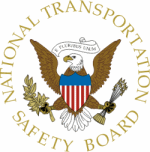Fri, Apr 22, 2011
Follows 2010 Fatal Accident In Wyoming
An accident in Wyoming in 2010 has prompted the NTSB to
recommend to the FAA that it make changes in instrument departure
procedures in the Jackson Hole, Wyoming area.

N201HF Route Of Flight
On October 25, 2010, about 1352 mountain daylight time,1 a
Mooney M20J airplane, N201HF, collided with mountainous terrain
near Lander, Wyoming.2 The pilot and three passengers were fatally
injured, and the airplane sustained substantial damage. The
airplane was operated under the provisions of 14 Code of Federal
Regulations (CFR) Part 91 as a personal flight. Instrument
meteorological conditions likely prevailed at the time of the
accident,3 which operated on an instrument flight rules (IFR)
flight plan to Pierre Regional Airport (PIR), Pierre, South Dakota.
The flight originated from Jackson Hole Airport (JAC), Jackson
Hole, Wyoming, at 1305.
After review of the air traffic control (ATC) services provided
to the pilot by Jackson Hole Air Traffic Control Tower and Salt
Lake City Air Route Traffic Control Center (Salt Lake Center), the
National Transportation Safety Board (NTSB) is concerned that the
published IFR departure procedures available to aircraft departing
JAC may be inadequate. In addition, the NTSB believes that the en
route automation modernization (ERAM) ATC software in use at Salt
Lake Center needs improvement to ensure that IFR aircraft are
afforded necessary en route minimum safe altitude warning (E-MSAW)
protection.

The NTSB recommends that the FAA Establish Standard Instrument
Departure procedures that provide transition routes and minimum
instrument flight rules altitude information for aircraft cleared
over commonly used navigational fixes from Jackson Hole Airport and
similarly situated airports. It further suggests that the agency
modify en route automation modernization software such that en
route minimum safe altitude warning alerts are provided for
aircraft in coast track status that are receiving automatic
position updates.
Finally, the NTSB says the FAA should modify en route automation
modernization software such that cautionary warnings are provided
to controllers when an aircraft is predicted to enter a minimum
instrument flight rules altitude (MIA) polygon below the MIA.
More News
Pilot Applied Full Aft Stick And Nose-Up Trim, But The Airplane Remained On The Runway Analysis: The pilot reported that a preflight inspection and flight control checks revealed n>[...]
A Few Questions AND Answers To Help You Get MORE Out of ANN! 1) I forgot my password. How do I find it? 1) Easy... click here and give us your e-mail address--we'll send it to you >[...]
From 2022 (YouTube Edition): Before They’re All Gone... Humankind has been messing about in airplanes for almost 120-years. In that time, thousands of aircraft representing i>[...]
Advanced Air Mobility (AAM) A transportation system that transports people and property by air between two points in the NAS using aircraft with advanced technologies, including el>[...]
Aero Linx: MQ-1B Predator The MQ-1B Predator is an armed, multi-mission, medium-altitude, long-endurance remotely piloted aircraft that is employed primarily as an intelligence-col>[...]
 NTSB Final Report: Douglas A-4K
NTSB Final Report: Douglas A-4K ANN FAQ: Q&A 101
ANN FAQ: Q&A 101 Classic Aero-TV: PBY Catalina--From Wartime to Double Sunrise to the Long Sunset
Classic Aero-TV: PBY Catalina--From Wartime to Double Sunrise to the Long Sunset ANN's Daily Aero-Term (07.01.25): Advanced Air Mobility (AAM)
ANN's Daily Aero-Term (07.01.25): Advanced Air Mobility (AAM) ANN's Daily Aero-Linx (07.01.25)
ANN's Daily Aero-Linx (07.01.25)




